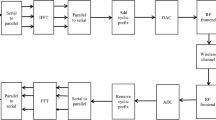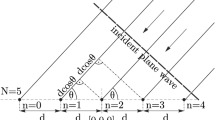Abstract
In Wideband direct sequence code division multiple access (WCDMA) same frequency spectrum is shared through all cells simultaneously, as opposed to TDMA which is used for most 2nd generation systems. In a WCDMA system all transmitted signals turn out to be disturbing factors to all other users in the system in the form of interference limiting the system capacity. To suppress the amount of interference, fast and reliable interference controlling algorithms must be employed in next generation systems. In this paper it is shown that antenna arrays with steer able low side lobes can reduce interference in WCDMA can increase the system capacity and output signal to noise ratio of the array processing architecture. The performance metric O/P SNR of an array processing architectures is simulated in an interfering environment to demonstrate the advantage of low side lobe beamforming over adaptive antennas.
Similar content being viewed by others
References
D. Karaminas and A. Manikas, “Super Resolution Broad Null Beamforming for Cochannel Interference Cancellation in Mobile Radio Networks”, IEEE Transaction of Vehicular Technology, Vol. 43, No. 3, pp. 689–697, May 2000.
S. Tanaka, A. Harada, T. Ihara, M. Sawahashi, and F. Adachi, “Combined Effect of Coherent Adaptive Antenna Array Diversity and SINR Based Fast Transmit Power Control in WCDMA Reverse Link”, IEICE Trans of Communications, Vol. E84-B, No. 3, pp. 425–433, March 2001
R. Kohno et al., “Combination of an Adaptive Array Antenna and a Canceller of Interference for Direct Sequence Spread Spectrum Multiple Access System”, IEEE JSAC, Vol. 8, No. 4, pp. 675–682, May 1990.
E. Buracchini et al., “Performance Analysis of a Mobile System Based on Combined SDMA/CDMA Access Technique”, IEEE ISSTA'96, Mainz, Germany, pp. 370–374, September 1996.
S. Durrani and M.E. Bailkowski, “Simulation of the Performance of Smart Antenna in the Reverse Link of CDMA System”, IEEE MTT-S Digest, pp. 575–578, 2003.
Lu Xiaode, G. Benquing, and L. Ruixiang, “Application of Monte Carlo Algorithm in Beamforming for smart antenna”, IEEE PIMRC, pp. 203–206, 2003.
P. Petrus, R. B. Ertel, and J. H. Reed, “Capacity Enhancement Using Adaptive Arrays in an AMPS System”, IEEE Trans. on Vehicular Technology, Vol. 47, No. 3, pp. 717–727, August 1998.
S. Choi and D. Yun, “Design of Adaptive Array for Tracking the Source of Maximum Power and its Application to CDMA Mobile Communications”, IEEE Trans. on Antenna Propagation, Vol. 45, No. 9, pp. 1393–1404, September 1997.
B.D. Van Veen and K.M. Buckley, “Beamforming: A Versatile Approach to Spatial Filtering”, IEEE ASSP Magazine, pp. 4–24, April 1988.
D.G. Manolakis, V.K. Ingle, and S.M. Kogon, Statistical and Adaptive Signal Processing. Boston: McGraw-Hill, 2000.
Dan E Dudgeon, “Fundamentals of Digital Array Processing”, Proceeding of the IEEE, Vol. 65, No. 6, pp. 98–104, June 1977.
Rajneesh Kumar, “System Level Improvements in Down Link of TD-CDMA Mobile Communications”, PhD Thesis, Indian Institute of Science, Bangalore, 2000.
Author information
Authors and Affiliations
Additional information
Rajesh Khanna was born in Ambala, India. He received B.Sc (Engg.) degree in Electronics & Comm. in 1988 from Regional Engineering College, Kurkshetra and M.E degree in 1998 from Indian Institute of Sciences, Bangalore He was with Hartron R&D centre till 1993. Until 1999 he was in All India Radio as Assistant Station Engineer. Presently he is working as Assistant Professor in the department of Electronics & Communication at Thapar Institute of Engineering & Technology, Patiala. He is also pursuing his PhD in the area of adaptive antennas for mobile communication. He has published 12 papers in national and International conferences.
Rajiv Saxena was born in Gwalior, India. He received his B.E degree in Electronics and Telecommunication Engineering from Jabalpur University, M.E degree in Elect Engg from Jiwaji University, Gwalior and PhD from University of Roorkee in 1982, 1990 and 1996 respectively. He worked as an engineer in GRASIM and Reliance Textile Industries till 1983. In 1984 he joined Electronics Engineering Department of Madhav Institute of Technology and Sciences, Gwalior as Lecturer. He became Reader in 1990 and Professor in 2002. Presently he is Principal Rustam Ji Institute of Technology, BSF Academy, Tekanpur Distt. – Gwalior (M.P.). He has published more than 53 papers in various national and International Journals and conferences. His research interests include wireless and mobile communication and Digital Signal Processing.
Rights and permissions
About this article
Cite this article
Khanna, R., Saxena, R. Output SNR Improvement in Array Processing Architectures of WCDMA Systems by Low Side Lobe Beamforming. Wireless Pers Commun 40, 205–214 (2007). https://doi.org/10.1007/s11277-006-9110-1
Published:
Issue Date:
DOI: https://doi.org/10.1007/s11277-006-9110-1




